The prevalence of mycoid diseases has made them recognizable and easily treatable conditions in their early stages. But the signs of athlete's foot themselves, which indicate the beginning of an infection, are not known to every person. After all, there are around fifty species of mushrooms alone. But there is also a broad category of skin diseases - epidermycosis. Therefore, in order to prevent the disease from developing into a health-threatening condition, it is necessary to study its features.
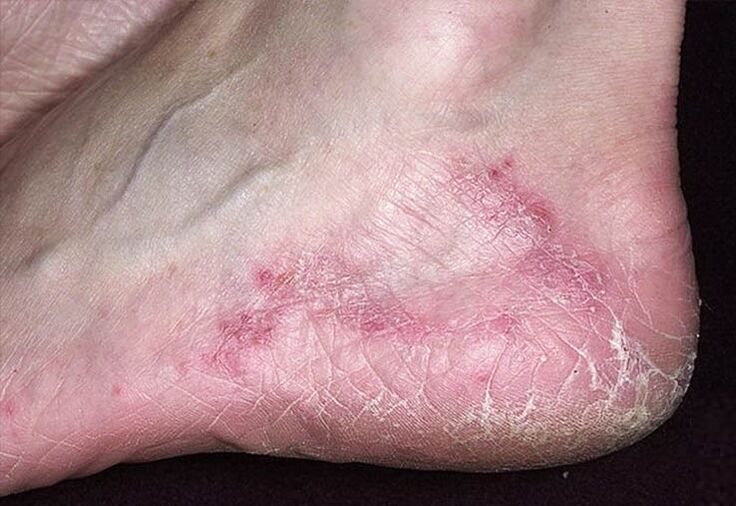
General characters
Among the diseases of the epidermis, fungal infections of the skin are the first. His signs are definitely recognizable. The main difficulty in diagnosis is determining the exact nature of the fungal infection. This is necessary because each of them is resistant to a certain group of antifungal drugs. Therefore, a mandatory visit to the doctor is required to carry out the treatment. Accurate identification of the mycoid group is not possible without special biological research.
The following signs may be a reason to see a specialist:
- Cracks in the epidermis between the toes. This area is considered to be most at risk for a fungal infection. Other signs of infection may include excessive dry skin, flaking on the feet, and pain.
- Significant thickening and roughening of the skin layer. Similar symptoms are observed when a corn or dry callus forms. However, in some cases the cause of this change is a fungus.
- Destruction of skin, blisters. Such injuries are often first diagnosed in one leg and then appear on the other.
- Redness of the epidermis, itching or burning. These symptoms are considered one of the main signals confirming a fungal infection. The difficulty of diagnosis in this case lies in the fact that each type of mycoid causes such a range of symptoms.
- Change in color of the nail plate.
- The appearance of an unpleasant odor in the infected area.
It is important to recognize the first signs of a fungus in a timely manner, as the disease is very difficult to treat and infection occurs easily.
Mycoid infection penetrates the body quite easily and infects internal organs and systems. This explains the frequent relapses of the disease without any external provoking factors.
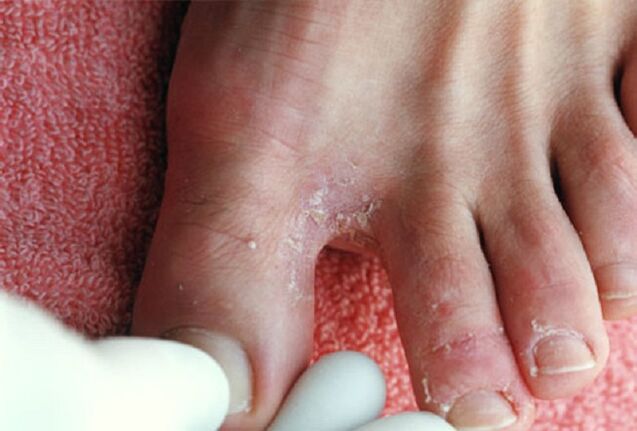
Medical classification
Mycosis fungoides is divided into four main forms based on their characteristic features.
For each form of athlete's foot, the symptoms vary depending on what it is:
- Squamous cell carcinoma.
- Dyshidrotic.
- Intertriginous.
- "Classic" onychomycosis.
The scaly or scaly form of a fungal infection is considered one of the initial stages of an infection. In this case, skin lesions are initially observed on one foot. Over time, a second infection occurs. The main symptom of the scaly form is redness of the skin, which subsequently develops into keratinization of inflamed tissue areas. Without treatment, the squamous cell carcinoma form develops into a dyshidrotic form.
The dyshidrotic form of mycoid infection has a pronounced characteristic feature - the appearance of small vesicles in the affected area. After opening, the blisters become inflamed and form a stable focus of erosion of the upper layers of the skin. The patient usually feels severe itching, which in more advanced cases turns into pain. The skin begins to peel off and erosions form regularly. This form of the disease can develop into the first form of squamous cell carcinoma without a system. For this reason, some experts believe that the mentioned forms of mycosis fungoides are two forms of the same type of infection.
The intertriginous form of infectious fungal infection is the most common. Manifestations of the disease include the appearance of cracks in the skin of the feet, visible to the naked eye, and the formation of peeling white areas of skin on the edges of the feet. For the interdigital area, the formation of weeping spots and erosion of the epidermis is a characteristic sign of the intertriginous form. The patient constantly feels itching in the infected area. The treatment of this form of infection is complex and lengthy because the disease usually takes a chronic course.
Onychomycosis is an infectious infection, the symptoms of which deserve special attention. Depending on the characteristics of the pathology, the type of damage to the nail plate and the nature of the disease change. There are three main types of onychomycosis:
- Hypertrophic – the nail plate gradually collapses, its color changes to yellowish and characteristic spots appear. After the nail is deformed, pain occurs in the affected area.
- Normotrophic – there is no destruction or change in the shape of the nail plate, spots or lines of yellowish and white color appear on it.
- Atrophic is the most dangerous form for the nail plate, in which it is severely destroyed, deformed and often detaches from the nail bed.
Each form of onychomycosis has its own general treatment regimen. However, in order to completely eliminate the infection without consequences for the body and to exclude relapse, it is recommended to carry out treatment on the recommendation and under the supervision of a doctor.
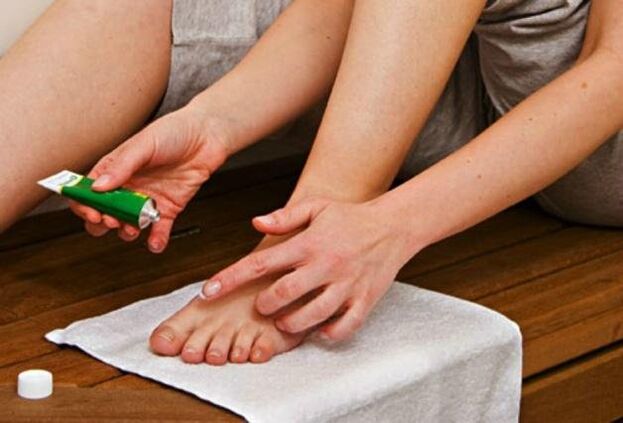
Treatment methods
In most cases, it is possible to completely eliminate a disease detected in time within a maximum of a month. This is a very important point in treatment, since itching, tissue damage and other manifestations disappear, and sometimes the patient stops treatment, believing that the disease has been defeated. But remnants of the infection can easily trigger a relapse.
Treatment procedures should be stopped only with the permission of the doctor and after passing the necessary tests. This is particularly true for advanced forms of the disease. The fungus is firmly "fixed" in the body and sometimes it can take at least six months to get rid of it. But the external manifestation of a fungus on the feet in the form of various skin or nail damage disappears much earlier, creating the illusion of health. When therapyIf stopped in this case, it is almost guaranteed that the patient will provoke a relapse.
Treatment of feet with mycoid infection is carried out comprehensively. To get rid of the disease, local antifungal drugs and tablets are used to eliminate the infectious agent that has entered the body. To eliminate itching, pain, brittle nails and accelerate tissue regeneration, certain medications may be prescribed. It is not recommended to independently combine them with the main therapy group so as not to provoke an allergic reaction or intoxication of the body due to the simultaneous use of incompatible drugs.
Curing athlete's foot in the early stages is very easy. Usually two weeks of therapy is enough to eliminate the symptoms of mycoid infection.
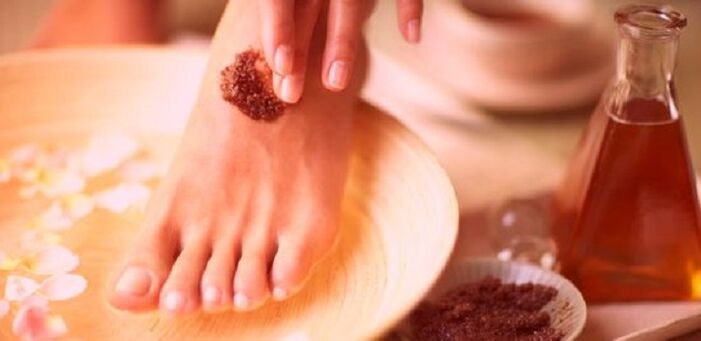
Duration of treatment
A combined infection of the skin and nail plate requires rehabilitation therapy for one to three months. These terms are considered the standard for the most effective medicines from a medical point of view.
Pregnancy requires a mandatory visit to the doctor to choose a method of eliminating mycoid infection. Effective drugs and therapies that require the use of similar drugs are prescribed only under medical supervision and in compliance with strict dosages. Many antibacterial tablets that effectively destroy fungi can cause noticeable harm to the fetus. Therefore, patients are recommended to be treated according to traditional medicine recipes whenever possible during pregnancy. Many of them allow you to cope with the disease, provided that the disease has not yet reached a complex stage. Only classical medicine can help deal with the advanced form.
Modern drugs allow you to fully restore your legs within two weeks, provided signs of infection are detected in a timely manner.
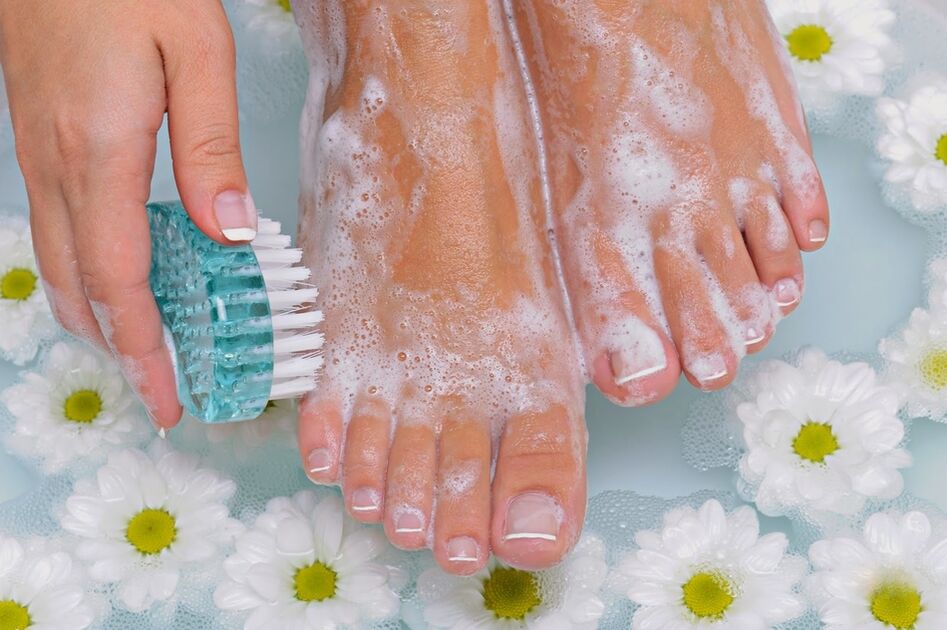
Precautions
Preventing an illness is always easier and safer from a health perspective than treating it, even with the most gentle method. In the case of a fungal infection, prevention is one of the mandatory norms of life, since infection occurs very easily. Therefore, to reduce the risk of contracting the disease, it is recommended to follow a few simple rules:
- Try to eat right and eat healthy foods whenever possible.
- Do not use other people's items and personal hygiene products.
- Use basic protective equipment such as spare shoes and hygienic antibacterials in public places.
- Wash your feet regularly and change your socks.
- live a healthy life;
- Take a bath regularly to improve the health of your feet.
- Disinfect shoes regularly.
Preventing a fungal infection is important not only to prevent it, but also when the disease actually occurs. In this situation, compliance with sanitary and hygienic standards will help speed up healing and prevent infection of others with the fungus.



























